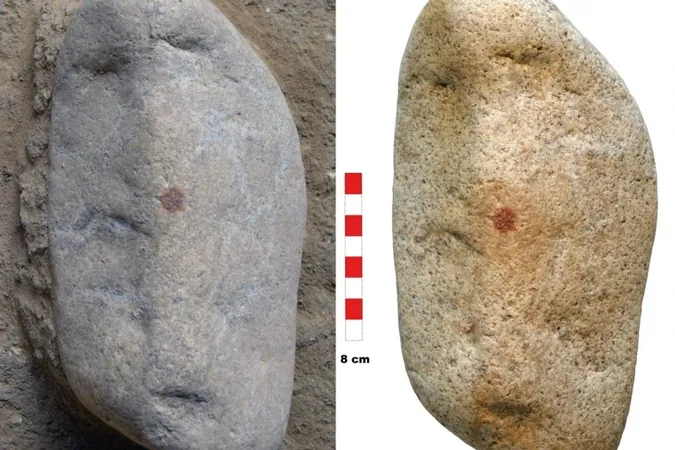
Did a Neanderthal Create the World's Oldest Fingerprint on a Face-Like Rock?
2025-05-31
Author: Ying
In a stunning archaeological discovery in a cave near Segovia, Spain, experts unearthed a hand-sized stone that resembles an elongated human face. This intriguing rock, marked with a splash of red ochre pigment on what could be interpreted as its nose, has sparked discussions about Neanderthal artistic expression.
David Álvarez Alonso, an archaeologist with Complutense University in Madrid, shared with The Guardian, "We were all thinking the same thing; this looks like a face." After three years of meticulous research, the team proposes that this stone could bear the world’s oldest recognized human fingerprint, potentially left by a Neanderthal who rolled their finger in ochre and pressed it onto the stone's surface.
Their findings, published in the journal Archaeological and Anthropological Sciences, suggest that this red dot’s placement hints at Neanderthals engaging in symbolic behavior, possibly representing one of the earliest forms of human art. This raises profound questions about their cognitive abilities.
Did Neanderthals Create Art?
The notion that Neanderthals might have created art or symbolic representations has long been debated. Co-author María de Andrés-Herrero mentioned to the BBC that recent findings are beginning to challenge previous beliefs about the timeline of artistic expression in human evolution.
To support their theory, researchers generated a 3D model of the rock's surface, measuring the relationships between features to demonstrate that the red dot aligns with where a human nose would typically be. They teamed up with geologists and employed multispectral analysis to confirm the ochre’s characteristics and unveil a fingerprint that could belong to an adult male Neanderthal.
The Skeptics' Viewpoint
However, not everyone is on board with this interpretation. Gilliane Monnier, an anthropology professor at the University of Minnesota, expressed her skepticism regarding the evidence presented. She noted that while the measurements suggest a face-like structure, that doesn’t necessarily prove Neanderthals recognized it as such.
Monnier questioned the claim that the red dot resulted from a human fingertip, arguing that natural processes could have created the markings instead. She called for geological expertise to assess the likelihood of natural formations versus human intervention.
Unraveling the Mystery
The researchers themselves admit that lingering doubts remain surrounding their hypothesis. They caution that their suggestion of pareidolia—seeing faces in inanimate objects—should be taken as a potential explanation, not a definite conclusion.
As archaeologists continue to explore this fascinating find, the face-like rock raises significant questions about the cognitive capabilities of Neanderthals and where exactly this discovery fits into the broader narrative of human history and artistic expression. The quest for clarity persists, as experts acknowledge that further research is essential to unravel this mysterious connection between our ancient relatives and the emergence of art.


 Brasil (PT)
Brasil (PT)
 Canada (EN)
Canada (EN)
 Chile (ES)
Chile (ES)
 Česko (CS)
Česko (CS)
 대한민국 (KO)
대한민국 (KO)
 España (ES)
España (ES)
 France (FR)
France (FR)
 Hong Kong (EN)
Hong Kong (EN)
 Italia (IT)
Italia (IT)
 日本 (JA)
日本 (JA)
 Magyarország (HU)
Magyarország (HU)
 Norge (NO)
Norge (NO)
 Polska (PL)
Polska (PL)
 Schweiz (DE)
Schweiz (DE)
 Singapore (EN)
Singapore (EN)
 Sverige (SV)
Sverige (SV)
 Suomi (FI)
Suomi (FI)
 Türkiye (TR)
Türkiye (TR)
 الإمارات العربية المتحدة (AR)
الإمارات العربية المتحدة (AR)